Kawasaki couldn't just sit there watching BMW, KTM, Suzuki, and Yamaha benefit from the adventure-tourer boom. With these big, street-oriented ADV machines stealing sales from standards and conventional sport-tourers , Big K had to get a piece.
That explains the Versys 1000, which finally comes to America for 2015. Introduced in 2012 for Europe and Asia, the V1K was, essentially, a tall Ninja 1000. It carried the familiar, torque-laden 1,043cc inline-four hung from an aluminum frame and wrapped in controversially styled bodywork similar to that of the smaller 650 Versys .
No more. For ’15, Kawasaki has redrawn the Versys family resemblance to look more like the rest of the Ninja line, featuring twin horizontally arrayed headlights, sharper creases in the character lines, and, generally, a more cohesive look. The V1000 and the Versys 650 have very similar if not identical forms.
Kawasaki positions the Versys 1000 simply: A sportier yet more touring oriented example of the Versys line. And that makes sense: The inline-four bangs out prodigious torque all over the rev range and is, thanks to new rubber engine mounts, smoother here than anywhere else it appears. Changes from the Ninja spec to Versys include shorter first and second gears, taller third-through-sixth gears, and taller overall gearing, which comprehensively answers our criticisms of the Ninja and Z1000 being ridiculously short-geared. Moreover, changes to the ECU programming, new cams with less lift and duration, and a reduced compression ration (now 10.8:1, down a full point from Ninja spec).
Where we might have asked for a little more character and, maybe, a bit of top-end surge in the Ninja application, the Versys state of tune is perfectly suited to the bike’s personality and mission. Once above 2,000 rpm, it pulls strongly and cleanly, with a muted but effective rush to the 10,000-rpm redline. You can spin it if you want to make best time, but short-shifting is just as effective at a street-wise pace. Indeed, you can make really good time never breaching 6,000 rpm. A slip-and-grip clutch offers light lever effort yet retains feel, and the gearbox is a peach. The only complaint is that the engine is slightly quick to take up at small throttle openings and low revs; keep the revs above 3,000 or so, and it’s really smooth and predictable. Overall, a great effort for a bike that’s meant to handle all kinds of roads, from the nasty, tight, pockmarked back roads to superhighways.
Similar praise for the chassis, which follows Ninja 1000 form in most ways. To ensure stability with a full passenger and baggage load, the Versys' steering-head angle has been kicked out to 27 degrees (from 24.5 in the Ninja) with the same 4 inches of trail. Longer-travel suspension helps deal with nasty pavement. Up front, the KYB inverted cartridge fork—with damping in just the right leg, springs in both—delivers 5.9 inches of travel (against 4.7 in the Ninja), while the linked single rear shock, also KYB, provides 5.9 inches of axle travel, half an inch more than on the Ninja. Spring rates are appropriate for a touring- and comfort-biased mission, but the baseline settings on front rebound are far too light. Adding a turn of rebound damping helped, but more time to experiment will tell us if the right setting is in there.
Where the Ninja 1000 is a solid, reasonably athletic performer, the Versys feels even lighter on its feet, thanks no doubt to the wide, fairly tall handlebar's leverage. (Ergonomics are more like a BMW R1200GS than the smaller, tighter Versys 650.) Still it's not as feathery light and wonderfully predictable as the smaller Versys, but the 1000 steers with fairly low effort and great accuracy. There's a slight tendency to resist turn-in on neutral throttle, but if it's on the brakes it'll heel over right quick. Moreover, the stock Bridgestone T30 sport-touring skins do a great job putting the power down. The press launch around the Sicilian city of Catania took place on cold, wet roads, yet traction events were relatively few and far between. We'd wager that most riders would be happier tossing the Versys down an unfamiliar road than they would the Ninja 1000. That's what confidence buys you.
Confidence comes from the electronic systems, including the non-linked ABS brakes. While the Ninja carries radial-mount calipers, the Versys 1000’s four-piston conventional-mount Tokicos do a fine job, with predictable come-in and plenty of power. Like the smaller Versys, the big brother loves to have a bit of rear brake before you hop on the front binders to settle the chassis.
In addition to the ABS, you get three-mode traction control (plus off) and two power levels, full and reduced. In reduced, the ECU alters fuel delivery and ignition timing to soften throttle response, and limits maximum power to 75 percent. We used the reduced mode in the wet and it was perfect.
In Europe, two versions of the Versys 1000 will be sold, but we get only the fully equipped LT, “light touring” iteration. It comes with the now-familiar 28-liter hard saddlebags and integrated mounts. Other options include a 47-liter top case, fog lights, and heated grips.
Where the Versys 1000 will score the biggest points is in value. At $12,799, the 1000 undercuts the MSRPs of all its intended competition, and not by just a little. Remember that it comes with hard luggage standard. Is the Versys as dynamically adept as a BMW GS? No, not quite. Is it as ferociously powerful as the KTM 1190 or Ducati Multistrada ? No way. But it is thousands cheaper, and even manages to undercut the comparatively tame Suzuki V-Strom 1000.
So big deal that Kawasaki waited a few years before bringing the Versys 1000 to the colonies. It’s been worth the wait for this more capable, much more handsome version.











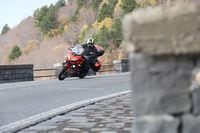

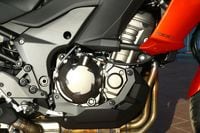
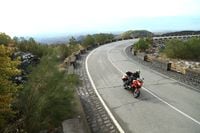
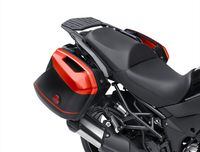


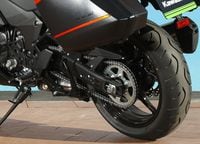

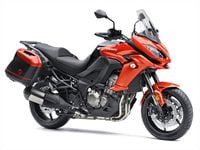
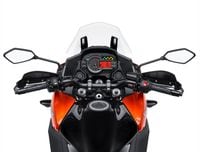
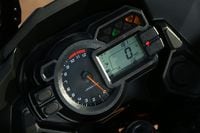

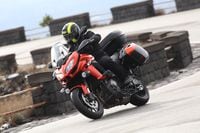
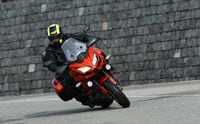
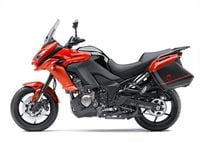
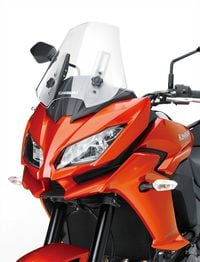
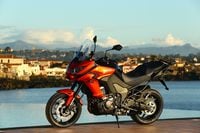
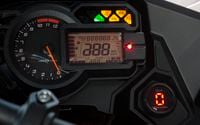

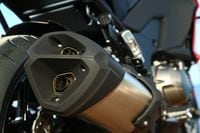

/cloudfront-us-east-1.images.arcpublishing.com/octane/7GJYDUIPXRGMTMQKN6ONYOLBOU.jpg)
/cloudfront-us-east-1.images.arcpublishing.com/octane/MUQLOVLL2ZDGFH25ILABNBXKTI.jpg)
/cloudfront-us-east-1.images.arcpublishing.com/octane/TNOU5DNE2BC57MFPMGN2EIDXAM.jpg)
/cloudfront-us-east-1.images.arcpublishing.com/octane/GTCXACQGJ5HAPDTGWUQKDEH44E.jpg)
/cloudfront-us-east-1.images.arcpublishing.com/octane/S35YGSEMEZB4BLTDJTSZPF4GLA.jpg)
/cloudfront-us-east-1.images.arcpublishing.com/octane/5UOT6HPX2JFMRJAX6EH45AR4MQ.jpg)
/cloudfront-us-east-1.images.arcpublishing.com/octane/OKWOJWAKP5EP3OACCRRWPCIX2Q.jpg)
/cloudfront-us-east-1.images.arcpublishing.com/octane/2WF3SCE3NFBQXLDNJM7KMXA45E.jpg)
/cloudfront-us-east-1.images.arcpublishing.com/octane/G4MG6OUCJNBSHIS2MVVOTPX65E.jpg)
/cloudfront-us-east-1.images.arcpublishing.com/octane/IIGGWFOTOJGB7DB6DGBXCCMTDY.jpg)
/cloudfront-us-east-1.images.arcpublishing.com/octane/QSTCM6AVEZA5JJBUXNIQ3DSOF4.jpg)
/cloudfront-us-east-1.images.arcpublishing.com/octane/U4I7G625B5DMLF2DVIJDFZVV6M.jpg)
/cloudfront-us-east-1.images.arcpublishing.com/octane/B6XD6LS6IVCQPIU6HXDJSM3FHY.jpg)
/cloudfront-us-east-1.images.arcpublishing.com/octane/ICL63FEDDRDTTMINYICCEYGMDA.jpg)
/cloudfront-us-east-1.images.arcpublishing.com/octane/FCGZHQXRBZFLBAPC5SDIQLVF4I.jpg)
/cloudfront-us-east-1.images.arcpublishing.com/octane/WNOB6LDOIFFHJKPSVIWDYUGOPM.jpg)

/cloudfront-us-east-1.images.arcpublishing.com/octane/X33NU3E525ECRHXLNUJN2FTRKI.jpg)
/cloudfront-us-east-1.images.arcpublishing.com/octane/6KKT5NNL2JAVBOXMZYS5ZO76YA.jpg)
/cloudfront-us-east-1.images.arcpublishing.com/octane/J5RKG5O455GMPGQRF2OG6LRT7A.jpg)
/cloudfront-us-east-1.images.arcpublishing.com/octane/GX2CIZKQVRH2TATDM26KFG2DAE.jpg)
/cloudfront-us-east-1.images.arcpublishing.com/octane/ZWIDYSAKQZHD5BHREMQILXJCGM.jpg)
/cloudfront-us-east-1.images.arcpublishing.com/octane/CYUHJZCTSJCH3MRAQEIKXK7SCQ.jpg)
/cloudfront-us-east-1.images.arcpublishing.com/octane/LKOFINY56FCXJCANJ5M7ZDQUBY.jpg)